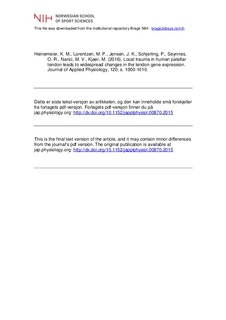| dc.contributor.author | Heinemeier, Katja M. | |
| dc.contributor.author | Lorentzen, Marc P. | |
| dc.contributor.author | Jensen, Jacob K. | |
| dc.contributor.author | Schjerling, Peter | |
| dc.contributor.author | Seynnes, Olivier R. | |
| dc.contributor.author | Narici, Marco V. | |
| dc.contributor.author | Kjaer, Michael | |
| dc.date.accessioned | 2017-05-08T07:41:08Z | |
| dc.date.available | 2017-05-08T07:41:08Z | |
| dc.date.issued | 2016-05-01 | |
| dc.identifier.citation | Journal of Applied Physiology. 2016, 120, 1000-1010 | nb_NO |
| dc.identifier.uri | http://hdl.handle.net/11250/2441833 | |
| dc.description | I Brage finner du siste tekst-versjon av artikkelen, og den kan inneholde ubetydelige forskjeller fra forlagets pdf-versjon. Forlagets pdf-versjon finner du på jap.physiology.org / In Brage you'll find the final text version of the article, and it may contain insignificant differences from the journal's pdf version. The definitive version is available at jap.physiology.org | |
| dc.description.abstract | Low cellular activity and slow tissue turnover in human tendon may prolong resolution of tendinopathy. This may be stimulated by moderate localized traumas such as needle penetrations, but whether this results in a widespread cellular response in tendons is unknown. In an initial hypothesis-generating study, a trauma-induced tendon cell activity (increased total RNA and collagen I mRNA) was observed after repeated patellar tendon biopsies in young men. In a subsequent controlled study, 25 young men were treated with two 0.8-mm-diameter needle penetrations [n = 13, needle-group (NG)] or one 2.1-mm-diameter needle biopsy [n = 12, biopsy-group (BG)] in one patellar tendon. Four weeks later biopsies were taken from treated (5 mm lateral from trauma site) and contralateral tendons for analyses of RNA content (ribogreen assay), DNA content (PCR based), and gene expression for relevant target genes (Real-time RT-PCR) (NG, n = 11 and BG, n = 8). Intervention increased RNA content, and mRNA expression of collagen I and III and TGF-β1 (P < 0.05), with biopsy treatment having greatest effect (tendency for RNA and collagen I). Results for DNA content were inconclusive, and no changes were detected in expression of insulin-like growth factor-I, connective tissue growth factor, scleraxis, decorin, fibromodulin, tenascin-C, tenomodulin, VEGFa, CD68, IL-6, MMP12, and MMP13. In conclusion, a moderate trauma to a healthy human tendon (e.g., biopsy sampling) results in a widespread upregulation of tendon cell activity and their matrix protein expression. The findings have implications for design of studies on human tendon and may provide perspectives in future treatment strategies in tendinopathy. | nb_NO |
| dc.language.iso | eng | nb_NO |
| dc.publisher | American Physiological Society | nb_NO |
| dc.subject | trauma | nb_NO |
| dc.subject | total RNA | nb_NO |
| dc.subject | injury | nb_NO |
| dc.subject | tendon fat | nb_NO |
| dc.title | Local trauma in human patellar tendon leads to widespread changes in the tendon gene expression | nb_NO |
| dc.type | Journal article | nb_NO |
| dc.type | Peer reviewed | nb_NO |
| dc.subject.nsi | VDP::Matematikk og Naturvitenskap: 400::Basale biofag: 470 | nb_NO |
| dc.subject.nsi | VDP::Medisinske Fag: 700::Basale medisinske, odontologiske og veterinærmedisinske fag: 710 | nb_NO |
| dc.source.journal | Journal of Applied Physiology | nb_NO |
| dc.identifier.doi | 10.1152/japplphysiol.00870.2015 | |
| dc.description.localcode | Seksjon for fysisk prestasjonsevne / Department of Physical Performance | nb_NO |
